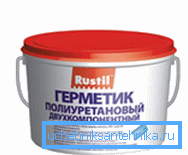Sealant for pipes - how to choose the best option for
Any specialist will confirm that the most problematic sections of the pipeline are various joints and mates. To improve the reliability of connections, it is recommended to use special compounds that serve as additional protection during operation. It is worth noting that there is no universal option, and sealant for water supply pipes is hardly suitable for chimneys, so we will consider the main options for various types of work.

Basic requirements for formulations and products
For whatever purpose the composition is selected, its suitability is determined by meeting a number of criteria:
| Compliance with the characteristics of the material manufacturing pipeline | Compounds used for systems made of PVC materials are unlikely to be suitable for metal communications. On the package there are always instructions for use, in which it is mandatory to indicate those materials with which the sealant can be used, and those to which it does not fit |
| Resistance to adverse effects | Sealant for water pipes must have a high moisture resistance, sealant for sewer pipes - resistant to aggressive chemical influences and fungi. And if you need to handle compounds on the chimney, then the best option would be a universal heat-resistant composition |
| Durability | A very important factor on which the service life of all communications directly depends. The compaction should retain all the original properties for at least several years, and for the most qualitative compositions this period is a decade, but their price is much higher than the budget options. |
| Elasticity | If, after solidification, the sealing composition retains plasticity, then it is much more resistant to temperature extremes, deformation effects and other adverse factors. |
Note! If the work is carried out outside buildings, then very important factors are resistance to ultraviolet radiation and adverse atmospheric influences, which destroy the structure of materials much faster.

Types of formulations
As noted above, for each type of communication different solutions are used, differing in their properties. We will consider which options are most preferable when working with your own hands.
For plumbing

When choosing a specific option for the type of communications under consideration, the following criteria should be considered:
- The temperature of the fluid passing through the system. For cold and warm water will suit any options, while for heating systems will need compositions that are resistant to high temperatures.
- The material used for the manufacture of pipes: metal and plastic varies considerably in its properties, respectively, the methods of sealing are also different.
- Operating conditions and the likelihood of exposure to aggressive chemical compounds.
The most popular today are silicone-based compounds.
Silicone sanitary sealant for pipe connections can be of the following types:
- Neutral silicone - an ideal sealant for plastic pipes, which has excellent adhesion to all types of plastic, glass and ceramics. This makes it very popular when used in a wide variety of plumbing systems. The composition is characterized by a short period of hardening and high elasticity, which guarantees durability, since after hardening it does not crack.
Note! When working with all types of silicone-based sealants, you must use gloves and ventilate the room well, since acetic acid is released during the curing process.
- Acid Sealant It is used mainly for metal pipes, as this option does not cause corrosion, and, therefore, ensures proper reliability of the joints over a long period of time.
The joints are also sealed with various tapes, they do not belong to the group of products we are considering, but can also be used for work, ensuring a sufficiently durable result.
For sewage
Sanitary sealant in sewage systems is used to strengthen the joints and make them resistant to aggressive chemical influences.
Nowadays, the same compositions are most often used as for plumbing, but their composition must contain antifungal components, since the operation of this type of communication is associated with constant exposure to high humidity and various harmful microorganisms.
In addition, other options can be used:
- Technical sulfur - this option is used for cast-iron sockets.
- Various bitumen-based mastics are used for large-diameter pipes when laying external communications.
- Compositions on epoxy and polyurethane on its properties resemble glue, so in the case of dismantling to separate the elements can be very difficult.

For chimneys
Sealant for chimneys and air ducts of heating equipment should have the highest resistance to high temperatures, two main options can be distinguished:
- Heat resistant - made on the basis of silicone, the temperature limit of use is about 350 degrees.
- Heat-resistant are made on the basis of silicates and are able to withstand temperatures up to 1500 degrees.

Conclusion
The use of sealing compounds can significantly improve the reliability of connections. The main thing is to choose the appropriate option, so we recommend watching the video in this article in order to understand the question in more detail. Remember, whatever option is used, it is imperative to test pipelines for strength and tightness before use.